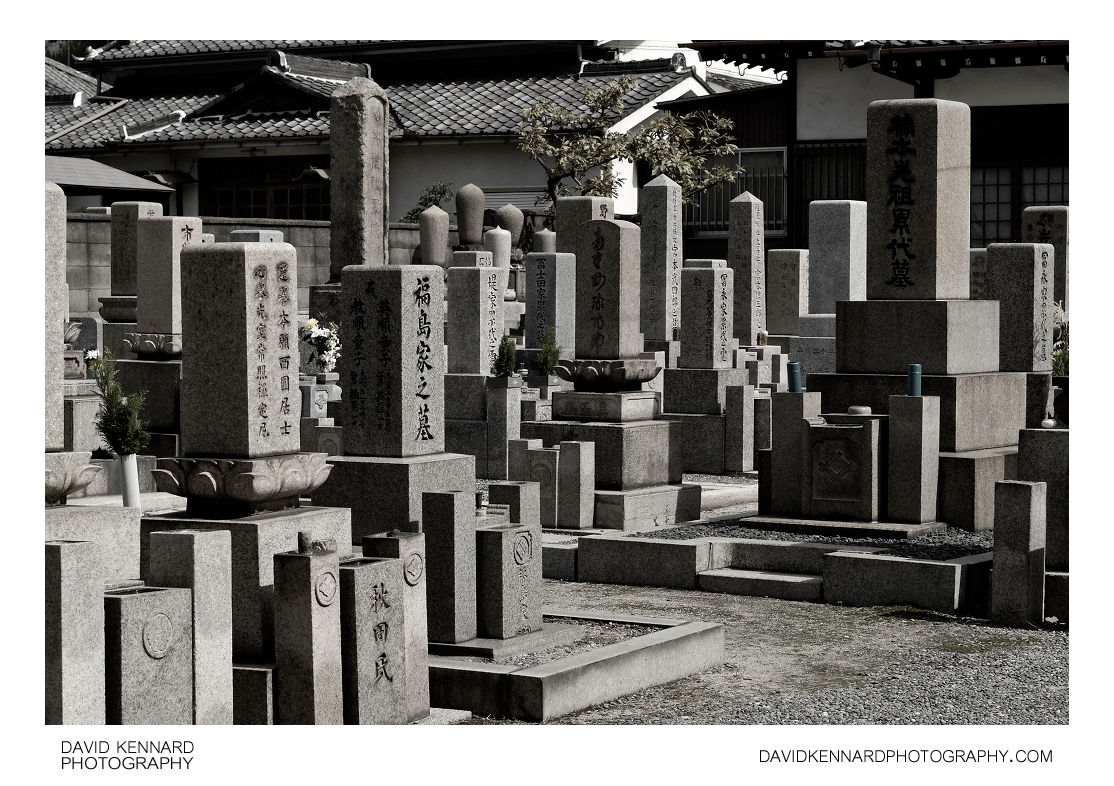Gravestones in Sainenji

Description
- Title:
- Gravestones in Sainenji
- Caption / Description:
-
Gravestones in Sainenji (西念寺) temple in Osaka, Japan.
From Wikipedia (http://en.wikipedia.org/wiki/Japanese_funeral#Grave):
A typical Japanese grave is usually a family grave (Japanese: 墓,haka) consisting of a stone monument, with a place for flowers, incense, and water in front of the monument and a chamber or crypt underneath for the ashes.
The date of the erection of the grave and the name of the person who purchased it may be engraved on the side of the monument. The names of the deceased are often but not always engraved on the front of the monument. When a married person dies before his or her spouse, the name of the spouse may also be engraved on the stone, with the letters painted red. After the death and the burial of the spouse the red ink is removed from the stone. This is usually done for financial reasons, as it is cheaper to engrave two names at the same time than to engrave the second name when the second spouse dies. It can also be seen as a sign that they are waiting to follow their spouse into the grave. However, this practice is less frequent nowadays. The names of the deceased may also be engraved on the left side, or on a separate stone in front of the grave. Often, the name is also written on a sotoba, a separate wooden board on a stand behind or next to the grave. These sotoba may be erected shortly after death, and new ones may be added at certain memorial services.
- Tags / Keywords:
-
- Asia
- Graveyard
- Japan
- 日本国
- Nihon-koku
- Kansai region
- 関西地方
- Kansai-chihō
- Osaka prefecture
- 大阪府
- Ōsaka-fu
- Osaka city
- 大阪市
- Ōsaka-shi
- Tennoji-ku
- 天王寺区
- Sainenji temple
- 西念寺
- 墓
Admin
- Date Original Photo Taken:
- Original File Name:
- _DSC1010a.nef
- Event:
- Rating:
- ☆
- Date this image added/last updated on website:
- Original File Dimensions:
- 3669px x 2455px
- File Type:
- JPEG
- Color Mode:
- Original Image Color Profile:
- Nikon Adobe RGB 4.0.0.3001
Location
- Location Shown:
-
- Sublocation:
- Sainenji
- City:
- Osaka
- Province/State:
- Osaka prefecture
- Country:
- Japan
- World Region:
- Asia
- Location Created:
-
- Sublocation:
- Sainenji
- City:
- Osaka
- Province/State:
- Osaka prefecture
- Country:
- Japan
- World Region:
- Asia
- Geo-location:
- 34.658026666667, 135.510735 View on map
Rights
- Copyright Status:
- Copyrighted
- Licensing Status:
- Rights Managed
- Available for Editorial Use:
- Yes
- Available for Commercial Use:
- No
- Copyright Notice:
- © 2009 Dave Kennard
Camera Data
- Date Digital Resource was created:
- Shutter speed:
- 1⁄180 s
- Aperture:
- f/8
- Camera Model:
- Nikon D200
- ISO:
- 100
- Exposure Compensation:
- 0
- Focal Length:
- 50mm
- Focal Length (35mm equiv.):
- 75mm
- Metering Mode:
- Multi-segment
- Flash:
- No Flash
- Exposure Mode:
- Auto
- White Balance:
- Manual
- Light Source:
- Cloudy
- Exposure Program:
- Aperture-priority AE
Additional shooting metadata
- Lens:
- Nikon AF Nikkor 50mm F1.4D
- Filters used:
- Additional Optics used:
- Setup:
- Handheld
Post Processing
- Image Modified:
- Software used:
-
- Nikon Capture NX 2
- Post Processing:
Straightened in CNX2
LCE applied in CNX2
B&W adjustment at 78% opacity in CNX2
